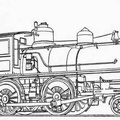The farmer sells his crop of wheat to the grain-dealer, and carts it, say, to Brandon, where the purchaser takes delivery of it at his elevator. Let us examine this thing somewhat minutely, taking by way of illustration one of the elevators belonging to the Canadian Pacific Railway Company at Montreal. It is a medium-sized one, having capacity for storing about 600,000 bushels of grain. The same company’s elevators at Fort William and Port Arthur are much larger, having capacity for 1,500,000 bushels. In Chicago and Buffalo there are elevators of three millions of bushels capacity; but, whether larger or smaller, in their main features they are all alike.
The elevator is a wooden structure of great strength. Its massive stone foundations rest on piles imbedded in concrete. The framework is so thoroughly braced and bolted together as to give it the rigidity of a solid cube, enabling it to resist the enormous pressure to which it is subjected when filled with 18,000 tons of wheat. The building is 210 feet long, 80 feet wide, and 142 feet in height from basement to the peak of the roof. Including the steam-engine (built at the C. P. R. works) of 240 horse-power, the entire cost of this elevator was $150,000. It consists of three distinct compartments—for receiving, storing, and delivering grain. On the ground floor are two lines of rails by which the cars have ingress and egress. The general appearance of this flat is that of a bewildering array of ponderous posts and beams, shafting, cog-wheels, pulleys and belts, blocks and tackle, chutes, and the windlasses for hauling in and out the cars, for a locomotive with its dangerous sparks may not cross the threshold. Beneath this, in the basement, are the receiving tanks, thirty-five feet apart from centre to centre, corresponding to the length of the cars. Of these there are nine, enabling that number of cars to be simultaneously unloaded. This is quickly done by a shovel worked by machinery, with the aid of two men, the grain falling through an iron grating in the floor into the tank. The elevator has nine “legs.” The leg is an upright box, 12 inches by 24 inches, extending from the bottom of the tank to the top of the building; inside of it is a revolving belt with buckets attached 15½ inches apart. The belt is 256 feet long, and as it makes 36 revolutions per minute, each bucket containing one-third of a bushel, each leg is able to raise 5,250 bushels per hour. A car is unloaded and its contents hoisted into the upper regions in fifteen minutes. When all the legs are at work 30,000 bushels are handled in an hour.
- Author
- Steam Navigation and Its Relation to the Commerce of Canada and the United States
By James Croil
Published in 1898
Available from gutenberg.org - Posted on
- Tuesday 23 February 2021
- Dimensions
- 900*666
- Tags
- Boats, Place:Canada, Railroad, Sailing Ship, Transport
- Visits
- 1751
- Downloads
- 33
 Download Photo
Download Photo





